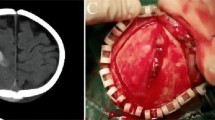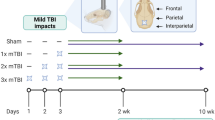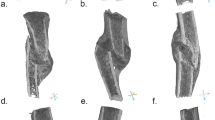Abstract
Background
Prior research and experience has increased physician understanding of infant skull fracture prediction. However, patterns related to fracture length, nonlinearity, and features of complexity remain poorly understood, and differences across infant age groups have not been previously explored.
Methods
To determine how infant and low-height fall characteristics influence fracture patterns, we collected data from 231 head CT 3D reconstructions and quantified length and nonlinearity using a custom image processing code. Regression analysis was used to determine the effects of age and fall characteristics on nonlinearity, length, and features of fracture complexity.
Results
While impact surface had an important role in the number of cracks present in a fracture, younger infants and greater fall heights significantly affected most features of fracture complexity, including suture-to-suture spanning and biparietal involvement. In addition, increasing fracture length with increasing fall height supports trends identified by prior finite-element modeling. Finally, this study yielded results supporting the presence of soft tissue swelling as a function of fracture location rather than impact site.
Conclusions
Age-related properties of the infant skull confer unique fracture patterns following head impact. Further characterization of these properties, particularly in infants <4 months of age, will improve our understanding of the infant skull’s response to trauma.
Impact
-
Younger infant age and greater fall heights have significant effects on many features of fracture complexity resulting from low-height falls.
-
Incorporating multiple crack formation and multiple bone involvement into computational models of young infant skull fractures may result in increased biofidelity.
-
Drivers of skull fracture complexity are not well understood, and skull fracture patterns in real-world data across infant age groups have not been previously described.
-
Understanding fracture complexity relative to age in accidental falls will improve the understanding of accidental and abusive head trauma.
This is a preview of subscription content, access via your institution
Access options
Subscribe to this journal
Receive 14 print issues and online access
$259.00 per year
only $18.50 per issue
Buy this article
- Purchase on Springer Link
- Instant access to full article PDF
Prices may be subject to local taxes which are calculated during checkout





Similar content being viewed by others
Data availability
In accordance with Springer Nature’s Data Policy Type 3, all relevant raw data will be freely available to any researcher wishing to use them for non-commercial purposes, without breaching subject confidentiality. The datasets generated or analyzed during the current study are available from the corresponding author upon reasonable request.
References
Mulligan, C. S., Adams, S., Tzioumi, D. & Brown, J. Injury from falls in infants less than one year. J. Paediatr. Child Health 53, 754–760 (2017).
Wegmann, H. et al. The epidemiology of fractures in infants – which accidents are preventable? Injury 47, 188–191 (2016).
Reece, R. M. & Sege, R. Childhood head injuries: accident or abuse? Arch. Pediatr. Adolesc. Med. 154, 11–15 (2000).
Wood, J. N. et al. Use and utility of skeletal surveys to evaluate for occult fractures in young injured children. Acad. Pediatr. 19, 428–437 (2019).
Laskey, A. L., Stump, T. E., Hicks, R. A. & Smith, J. L. Yield of skeletal surveys in children ≤ 18 months of age presenting with isolated skull fractures. J. Pediatr. 162, 86–89 (2013).
Deye, K. P., Berger, R. P. & Lindberg, D. M., ExSTRA Investigators. Occult abusive injuries in infants with apparently isolated skull fractures. J. Trauma Acute Care Surg. 74, 1553–1558 (2013).
Kalichman, S. C. & Brosig, C. L. Mandatory child abuse reporting laws: issues and implications for policy. Law Policy 14, 153–168 (1992).
Hobbs, C. J. Skull fracture and the diagnosis of abuse. Arch. Dis. Child. 59, 246–252 (1984).
Leventhal, J. M., Thomas, S. A., Rosenfield, N. S. & Markowitz, R. I. Fracture in young children: distinguishing child abuse from unintentional injury. Am. J. Dis. Child. 147, 87–92 (1993).
Kemp, A. M. et al. Patterns of skeletal fractures in child abuse: systematic review. BMJ 337, a1518 (2008).
Metz, J. B. et al. Are complex skull fractures indicative of either child abuse or major trauma in the era of 3-dimensional computed tomography imaging? Pediatr. Emerg. Care. 38, e200–e204 (2022).
Coats, B., Ji, S. & Margulies, S. S. Material properties of human infant skull and suture at high rates. J. Neurotrauma 23, 1222–1232 (2006).
Metcalf, R. M., Comstock, J. M. & Coats, B. High-rate anisotropic properties in human infant parietal and occipital bone. J. Biomech. Eng. 143, 061010 (2021).
Weber, W. Biomechanical fragility of the infant skull. Z. Rechtsmed. 94, 93–101 (1985). German.
Li, Z. et al. A statistical skull geometry model for children 0-3 years old. PLoS ONE 10, e0127322 (2015).
Coats, B., Margulies, S. S. & Ji, S. Parametric study of head impact in the infant. Stapp Car Crash J. 51, 1–15 (2007).
Li, Z. et al. Development, validation, and application of a parametric pediatric head finite element model for impact simulation. Ann. Biomed. Eng. 39, 2984–2997 (2011).
Li, X., Sandler, H. & Kleiven, S. The importance of nonlinear tissue modelling in finite element simulations of infant head impacts. Biomech. Model Mechanobiol. 16, 823–840 (2017).
He, J., Yan, J., Margulies, S., Coats, B. & Spear, A. D. An adaptive-remeshing framework to predict impact-induced skull fracture in infants. Biomech. Model Mechanobiol. 19, 1595–1605 (2020).
Yan, J., He, J., Spear, A. & Coats, B. The effect of impact angle and fall height on skull fracture patterns in infants. J. Biomech. Eng. 143, 071004 (2021).
Kleinman, P. K., Coats, B. & Silvera V. M. Abusive head trauma: scalp, subscalp, and cranium. In: Diagnostic Imaging of Child Abuse (ed Kleinman, P. K.) 357–393 (Cambridge University Press, United Kingdom, 2015).
Chaudhary, S., et al. Pediatric falls ages 0–4: understanding demographics, mechanisms, and injury severities. Inj. Epidemiol. 5, 7 (2018).
Thompson, A. K., Bertocci, G. & Pierce, M. C. Assessment of head injury risk associated with feet-first free falls in 12-month-old children using an anthropomorphic test device. J. Trauma 66, 1019–1029 (2009).
Bertocci, G. et al. Influence of fall height and impact surface on biomechanics of feet-first free falls in children. Injury 35, 417–424 (2004).
Pinto, P. S., Poretti, A., Meoded, A., Tekes, A. & Huisman, T. A. G. M. The unique features of traumatic brain injury in children: Review of the characteristics of the pediatrics skull and brain, mechanisms of trauma, patterns of injury, complications and their imaging findings – part 1. J. Neuroimaging 22, e1–e17 (2012).
Margulies, S. S. & Thibault, K. L. Infant skull and suture properties: measurements and implications for mechanisms of pediatric brain injury. J. Biomech. Eng. 122, 364–371 (2000).
Ibrahim, N. & Margulies, S. S. Biomechanics of the toddler head during low-height falls: an anthropomorphic dummy analysis. J. Neurosurg. Pediatr. 6, 57–68 (2010).
Parks, S., Annest, J., Hill, H. & Karch, D. Pediatric Abusive Head Trauma: Recommended Definitions for Public Health Surveillance and Research (Centers for Disease Control and Prevention, Atlanta, GA, 2012).
Kriss, S., Morris, J. & Martich, V. Cranial suture evaluation in pediatric head trauma: Importance in differentiating abusive from accidental injury. Pediatr. Emerg. Care. 38, e703–e708 (2022).
Kriss, S., Morris, J. & Martich, V. Pediatric skull fractures contacting sutures: relevance in abusive head trauma. AJR Am. J. Roentgenol. 217, 218–222 (2021).
Uçan, B., Tokur, O. & Aydin, S. Pediatric skull fractures: could suture contact be a sign of abuse? Emerg. Radiol. 29, 403–408 (2022).
Metz, J. B. et al. Fracture-associated bruising and soft tissue swelling in young children with skull fractures: how sensitive are they to fracture presence? Pediatr. Emerg. Care. 37, e1392–e1396 (2021).
O’Hara, M. A. The infant with bilateral skull fractures: diagnostic considerations in consultation with a child abuse pediatrician. J. Inj. Violence Res. 11, 15–20 (2019).
Arnholz, D., Hymel, K. P., Hay, T. C. & Jenny, C. Bilateral pediatric skull fractures: accident or abuse? J. Trauma. 45, 172–174 (1998).
Aysha, A., Morantz, G., Lacroix, C., Saint-Martin, C. & Dudley, R. W. R. Bilateral parietal skull fractures in infants attributable to accidental falls. Pediatr. Neurosurg. 56, 424–431 (2021).
O’Hara, M. A. et al. Understanding bilateral skull fractures in infancy: a retrospective multicenter case review. Pediatr. Emerg. Care. Epub ahead of print (2022).
Acknowledgements
Statistical support was provided by the National Center for Advancing Translational Sciences of the National Institutes of Health under Award Number UL1TR002538. The content is solely the responsibility of the authors and does not necessarily represent the official views of the National Institutes of Health. In addition, the authors would like to acknowledge Primary Children Hospital’s Pediatric Radiology Department for guidance and assistance with a radiological review.
Funding
This work was supported by Award No. 2016-DN-BX-0160 and 2020-75-CX-0014, provided by the National Institute of Justice, Office of Justice Programs, U.S. Department of Justice. The opinions, findings, and conclusions or recommendations expressed in this publication are those of the authors and do not necessarily reflect those of the Department of Justice.
Author information
Authors and Affiliations
Contributions
T.M.R.-M. has substantially contributed to the conception and design of this study; has collected, analyzed, and interpreted data; and has written the manuscript. Y.A. performed image analysis and collected data. B.C. designed this study, analyzed and interpreted the data, and also wrote the manuscript. All three authors read, critically revised, and approved the final manuscript.
Corresponding author
Ethics declarations
Competing interests
T.M.R.-M. has provided medicolegal consultation and expert testimony on cases of suspected child abuse and neglect. No other competing interests were noted by the authors.
Ethics approval and consent to participate
This study was reviewed and approved by the University of Utah Institutional Review Board (IRB) and was deemed to be exempt research. Therefore, consent was not required for this study.
Additional information
Publisher’s note Springer Nature remains neutral with regard to jurisdictional claims in published maps and institutional affiliations.
Rights and permissions
Springer Nature or its licensor (e.g. a society or other partner) holds exclusive rights to this article under a publishing agreement with the author(s) or other rightsholder(s); author self-archiving of the accepted manuscript version of this article is solely governed by the terms of such publishing agreement and applicable law.
About this article
Cite this article
Ruiz-Maldonado, T.M., Alsanea, Y. & Coats, B. Age-related skull fracture patterns in infants after low-height falls. Pediatr Res 93, 1990–1998 (2023). https://doi.org/10.1038/s41390-022-02345-9
Received:
Revised:
Accepted:
Published:
Issue Date:
DOI: https://doi.org/10.1038/s41390-022-02345-9



